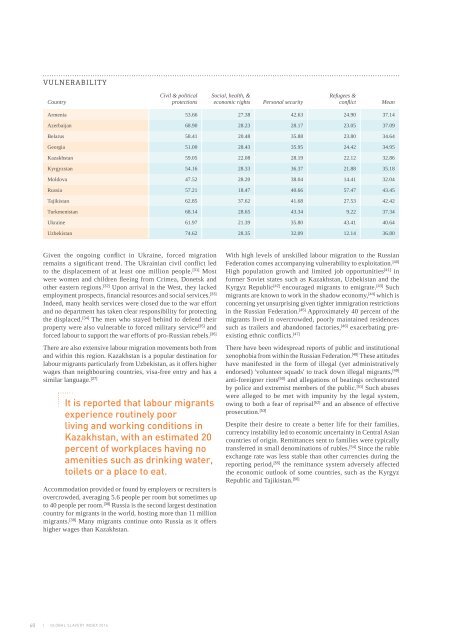GSI-2016-Full-Report
GSI-2016-Full-Report
GSI-2016-Full-Report
Create successful ePaper yourself
Turn your PDF publications into a flip-book with our unique Google optimized e-Paper software.
VULNERABILITY<br />
Country<br />
Civil & political<br />
protections<br />
Social, health, &<br />
economic rights<br />
Personal security<br />
Refugees &<br />
conflict<br />
Mean<br />
Armenia 53.66 27.38 42.63 24.90 37.14<br />
Azerbaijan 68.90 28.23 28.17 23.05 37.09<br />
Belarus 58.41 20.48 35.88 23.80 34.64<br />
Georgia 51.00 28.43 35.95 24.42 34.95<br />
Kazakhstan 59.05 22.08 28.19 22.12 32.86<br />
Kyrgyzstan 54.16 28.33 36.37 21.88 35.18<br />
Moldova 47.52 28.20 38.04 14.41 32.04<br />
Russia 57.21 18.47 40.66 57.47 43.45<br />
Tajikistan 62.85 37.62 41.68 27.53 42.42<br />
Turkmenistan 68.14 28.65 43.34 9.22 37.34<br />
Ukraine 61.97 21.39 35.80 43.41 40.64<br />
Uzbekistan 74.62 28.35 32.09 12.14 36.80<br />
Given the ongoing conflict in Ukraine, forced migration<br />
remains a significant trend. The Ukrainian civil conflict led<br />
to the displacement of at least one million people. [31] Most<br />
were women and children fleeing from Crimea, Donetsk and<br />
other eastern regions. [32] Upon arrival in the West, they lacked<br />
employment prospects, financial resources and social services. [33]<br />
Indeed, many health services were closed due to the war effort<br />
and no department has taken clear responsibility for protecting<br />
the displaced. [34] The men who stayed behind to defend their<br />
property were also vulnerable to forced military service [35] and<br />
forced labour to support the war efforts of pro-Russian rebels. [36]<br />
There are also extensive labour migration movements both from<br />
and within this region. Kazakhstan is a popular destination for<br />
labour migrants particularly from Uzbekistan, as it offers higher<br />
wages than neighbouring countries, visa-free entry and has a<br />
similar language. [37]<br />
It is reported that labour migrants<br />
experience routinely poor<br />
living and working conditions in<br />
Kazakhstan, with an estimated 20<br />
percent of workplaces having no<br />
amenities such as drinking water,<br />
toilets or a place to eat.<br />
Accommodation provided or found by employers or recruiters is<br />
overcrowded, averaging 5.6 people per room but sometimes up<br />
to 40 people per room. [38] Russia is the second largest destination<br />
country for migrants in the world, hosting more than 11 million<br />
migrants. [39] Many migrants continue onto Russia as it offers<br />
higher wages than Kazakhstan.<br />
With high levels of unskilled labour migration to the Russian<br />
Federation comes accompanying vulnerability to exploitation. [40]<br />
High population growth and limited job opportunities [41] in<br />
former Soviet states such as Kazakhstan, Uzbekistan and the<br />
Kyrgyz Republic [42] encouraged migrants to emigrate. [43] Such<br />
migrants are known to work in the shadow economy, [44] which is<br />
concerning yet unsurprising given tighter immigration restrictions<br />
in the Russian Federation. [45] Approximately 40 percent of the<br />
migrants lived in overcrowded, poorly maintained residences<br />
such as trailers and abandoned factories, [46] exacerbating preexisting<br />
ethnic conflicts. [47]<br />
There have been widespread reports of public and institutional<br />
xenophobia from within the Russian Federation. [48] These attitudes<br />
have manifested in the form of illegal (yet administratively<br />
endorsed) 'volunteer squads' to track down illegal migrants, [49]<br />
anti-foreigner riots [50] and allegations of beatings orchestrated<br />
by police and extremist members of the public. [51] Such abuses<br />
were alleged to be met with impunity by the legal system,<br />
owing to both a fear of reprisal [52] and an absence of effective<br />
prosecution. [53]<br />
Despite their desire to create a better life for their families,<br />
currency instability led to economic uncertainty in Central Asian<br />
countries of origin. Remittances sent to families were typically<br />
transferred in small denominations of rubles. [54] Since the ruble<br />
exchange rate was less stable than other currencies during the<br />
reporting period, [55] the remittance system adversely affected<br />
the economic outlook of some countries, such as the Kyrgyz<br />
Republic and Tajikistan. [56]<br />
68 | GLOBAL SLAVERY INDEX <strong>2016</strong>


